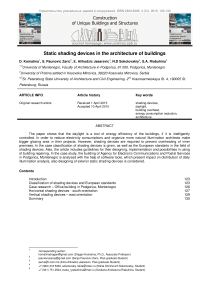Static shading devices in the architecture of buildings
Автор: Komatina Dragan, Paunovic Zaric Sanja, Alihodzic Jasarevic Ema, Sokolovskiy Nikita Dmitrievich, Riabuhina Svetlana Andreevna
Журнал: Строительство уникальных зданий и сооружений @unistroy
Статья в выпуске: 4 (31), 2015 года.
Бесплатный доступ
The paper shows that the daylight is a tool of energy efficiency of the buildings, if it is intelligently controlled. In order to reduce electricity consumptions and organize more natural illumination architects make bigger glazing area in their projects. However, shading devices are required to prevent overheating of inner premises. In the case classification of shading devices is given, as well as the European standarts in the field of shading devices. Also, the article includes guidelines for their designing, implementation and possibilities in using of building repairing. In the case study, the building of Agency for Electronic Communications and Postal Services in Podgorica, Montenegro is analyzed with the help of software tools, which present impact on distribution of daily illumination analysis, also designing of exterior static shading devices is considered.
Shading devices, daylight, building overheat, energy consumption reduction, architecture
Короткий адрес: https://sciup.org/14322231
IDR: 14322231
Список литературы Static shading devices in the architecture of buildings
- Boubekri M. Daylighting architecture and health (2008) Architectural Press, Oxford, UK, pp. 1-144.
- Kittler R., Kocifaj M., Darula S. Daylight Science and Daylighting Technology (2012) Sprinter New York, Dordrecht, Heidelberg, London, pp. 1-256.
- Ander D. G. Daylighting performance and design (2003) John Wiley&Sins Inc, Honoken, New Jersey, pp. 1-336.
- Brandi U., Geissmar C. LIGHTBOOK: The practice of lighting design (2001) Birkhäuser, Boston, USA, pp. 1-255.
- Gary S. Architectural light design -3rd edition (2008) Wiley, New York, USA, pp. 1-368.
- Phillips D. Daylighting (Natural light in architecture) (2004) Architectural Press, Oxford, pp. 1-212.
- Lewis J.O. A Green Vitruvius: Principles and practice of sustainable architecture design (1999) James&James, London, UK, pp. 1-145.
- Francesca A., Cappelletti A., Gasparella A. Internal Versus External Shading Devices Performance in Office Buildings (2014) Energy Procedia, 45, pp. 463-472.
- Autodesk-USA. URL: http://usa.autodesk.com/ecotect-analysis/(Date of reference 24.04.15).
- CIE. URL: http://www.cie.co.at/Publications/index.php?i_ca_id=476 (Date of reference 24.04.15).
- Tregenza P., Wilson M. Daylighting: Architecture and Lighting Design (2013) Routledge, pp. 1-304.
- Krygiel E. & Others. Architectural Daylighting Analysis (2011) pp. 1-38.
- Jakubiec A. Reinhart C. DIVA 2.0: Integrating daylight and thermal simulations using Rhinoceros 3d, Daysm and Energyplus (2011) 12th Conference of International Building Performance Simulation Association, Sydney. pp. 1-8.
- Manzan M. Genetic optimization of external fixed shading devices (2014) Energy and Buildings, 72, pp. 431-440.
- Kim G., Lim H. S., Lim T. S., Schaefer L., Kim J. T. Comparative advantage of an exterior shading device in thermal performance for residential buildings (2012) Energy and Buildings, 46, pp. 105-111.
- Cheng C., Liao L., Chou C. A study of summarized correlation with shading performance for horizontal shading devices in Taiwan (2013) Solar Energy, 90, pp. 1-16.
- “Gidroproekt” building in Moscow, Russia. URL: http://ubr.ua/labor-market/life-at-work/evoluciia-ofisnogo-prostranstva-chast-i-306898 (Date of reference 24.04.15).
- Doha Tower in Quatar, architected by Jean Nouvel. URL: http://skyscrapercenter.com/building/doha-tower/1083 (Date of reference 24.04.15).
- The Agency for Electronic Communications and Postal Services in Podgorica, Montenegro. URL: http://www.skyscrapercity.com/showthread.php?t=1592578 (Date of reference 24.04.15).
- Gratia E., Herde A. The most efficient position of shading devices in a double-skin façade (2007) Energy and Buildings, 39 (3), pp. 364-373.
- Moeseke G., Bruyère I., Herde A. Impact of control rules on the efficiency of shading devices and free cooling for office buildings (2007) Building and Environment, 42(2), pp. 784-793.
- Palmero-Marrero A. I., Oliveira A. C. Effect of louver shading devices on building energy requirements (2010) Applied Energy, 87(6), pp. 2040-2049.
- Cho J., Yoo C., Kim Y. Viability of exterior shading devices for high-rise residential buildings: Case study for cooling energy saving and economic feasibility analysis (2014) Energy and Buildings, 82, pp. 771-785.
- Ahmed A.Y. Impact of external shading devices on thermal and daylighting performance of offices in hot climate regions (2014) Solar Energy, 102, pp. 14-30
- Mandalaki M., Papantoniou S.,Tsoutsos T. Assessment of energy production from photovoltaic modules integrated in typical shading devices (2014) Sustainable Cities and Society, 10, pp. 222-231.
- Radovic, G., Murgul, V., Cvetkovska, M., Aronova, E., Vatin, N. Solar power supply for remote objects of historical heritage in Montenegro (2014) Journal of Applied Engineering Science, Vol. 12 (4), pp. 277 -284.
- Radovic, G., Murgul, V., Vatin, N., Aronova, E. Hybrid photovoltaic-diesel energy system optimization (case study of electric power supply for buildings under the weather conditions of Montenegro) (2014) Applied Mechanics and Materials, Vol. 627, pp. 357-364.
- Murgul, V., Vatin, N., Aronova, E. Solar power supply in the system of restoration and reconstruction remote historic and cultural objects (on the example of Montenegro) (2014) Applied Mechanics and Materials, Vol. 635-637, pp. 2029-2035.


